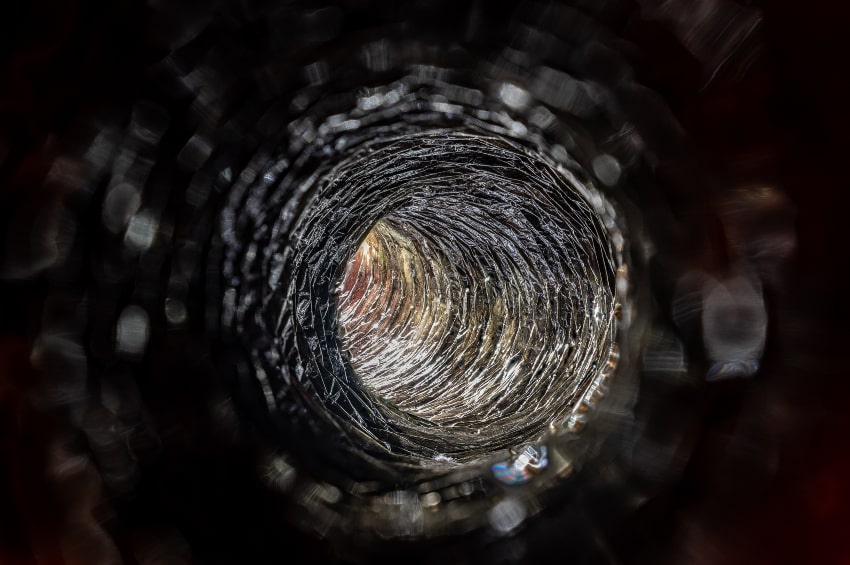The Value of Keeping Ducts Clean
Posted on by WestAIR Heating & Cooling
Several years ago, we wrote about a topic that affects virtually every homeowner – dryer vents. Now, we want to revisit this idea to reiterate the value of keeping ducts clean. We also want to offer some safety tips along with signs that your ducts need attention. Keep reading to learn more.
Stay Safe from Harm
You likely clean the clothes dryer lint catch before or after drying a load of clothes. That trap can sometimes miss a piece of lint here or there, and those pieces may end up in the dryer vent hose. If too many of those small pieces collect over time, the vent can become clogged, forcing potentially dangerous fumes back into your home.
Additionally, dryer lint is flammable. And clothes dryers use warm – often hot – air to dry a load of laundry. In some instances, flammable lint mixed with hot air can be an unsafe combination. Each year, clothes dryer fires cause death, injury, and millions of dollars in property loss or damage. Failure to keep up with dryer maintenance is the leading cause of clothes dryer fires. As such, keeping the vent clear of obstruction dramatically helps keep you and your family safe.
Better For Your Appliances
A clogged dryer vent slows the drying process and makes the unit work harder and longer to get clothes dry. This creates undue stress and added wear-and-tear on the dryer itself. Keeping the vent clean and clear helps improve function and allows the dryer to run more efficiently. You’ll save money on energy bills and help cut down on repairs.
Watch for These Signs
There are some signs to watch for that could indicate it’s time to clean the dryer vent – or call on a team of professionals to get the job done. Pay attention to things like:
- Longer dry times. If the damp, hot air can’t escape due to a clogged vent, you’ll notice it takes longer to dry your clothes. This creates unnecessary wear on the dryer as well as the laundry.
- Something smells like it’s burning. Lint that has collected in the vent can start a dryer fire. If you smell something burning, turn off the unit and have a trusted service technician inspect the vent and the dryer.
- Materials are hot. Clothes that come fresh from the dryer should be warm and dry – but not hot. Hot materials mean the dryer isn’t venting properly. Have the dryer looked at and the vent cleaned to help prevent overheating or a fire.
- The vent cover stays closed. When the dryer is running, the exterior vent cover should open to allow hot air to escape. If the vent cover stays closed, the hose may be clogged with dryer lint.
Keep Ducts Clean with WestAIR
When it comes to safety, the value of keeping ducts clean cannot be overstated. These are simple ways to be on alert to help protect your home, your family, and your appliances. If you notice any of these signs, schedule an appointment with the professionals at WestAIR Heating & Cooling. Our duct cleaning service provides removal of dirt and other debris from your home’s ductwork, delivering peace of mind and cleaner air. Contact us today to learn more.
This entry was posted in Duct Cleaning and tagged clothes dryer, dryer vent, Duct cleaning, Duct cleaning service, Ducts, Ductwork
7 Winter Furnace Maintenance Tips
Posted on by WestAIR Heating & Cooling

We rely on our heating systems a lot during Minnesota’s long, brutal winters. As we continue through the coldest months of the year, homeowners should take steps to minimize stress on their HVAC system to help prevent inconvenient breakdowns and costly repairs. Use these winter furnace maintenance tips to enjoy optimal performance, efficiency, and comfort all season long.
- Keep the air filter clean. A clogged filter forces the HVAC system to work harder, decreases efficiency, and is also the most common cause of breakdowns. Be sure to change or clean your air filter every month.
- Maintain a clear, clean area around the unit. Giving your furnace room to breathe promotes safe, efficient operation, as well as easy access to the unit for you or your HVAC specialist if necessary. As a general rule, give your furnace or indoor air handling unit three feet of clearance and clean the space regularly.
- Inspect flue pipes for damage. Your furnace naturally produces gases during the combustion process, and flue pipes carry these gases to your home’s ventilation system to be safely exhausted. Check the pipes for any damage that could be leaking CO into the home, as well as signs of soot and/or rusting. Have an experienced HVAC technician inspect any issues immediately.
- Clean supply and return vents. Supply vents feed warm air produced by your furnace to your home; return vents pull old indoor air and deliver it to the HVAC system to maintain indoor air quality and comfort. Cleaning them helps prevent dust and other airborne irritants from getting into the air you breathe or sucked back into the system.
- Check for signs of dirty ductwork. Air ducts carry air between your HVAC system and home and naturally collect dirt, dust, and other debris over time. Issues to look for include mold around your vents or furnace, excessive dust accumulation (especially around vents), inconsistent heating throughout the home, unexplained increases in allergy symptoms and/or respiratory problems, and signs of a rodent or pest infestation. Schedule professional duct cleaning service if you see any of these, and plan to do so annually.
- Turn the temperature down but keep the system on. Turning the thermostat down at night or when the house is empty can help cut utility costs, but don’t turn the system completely off. Having to fire the furnace back up whenever you wake up or return home requires more energy and adds unnecessary stress. Just remember to go no lower than 55 degrees (or closer to 60 during extreme cold) to help prevent frozen pipes. For ultimate ease and efficiency, consider installing a programmable thermostat that lets you pre-set temperature settings for multiple days ahead of time.
- Don’t ignore the warning signs. Don’t wait for a complete breakdown to give your furnace the attention it needs. If you notice uneven or inefficient heating, unexplained spikes in energy bills, or any other furnace issue warning signs, call WestAIR for professional diagnosis and repair before the issue gets worse.
It may be the beginning of a new year, but we have a lot of cold days and harsh weather ahead of us yet. Follow these winter furnace maintenance tips to help your heating system run safely, efficiently, and uninterrupted for the rest of the season.
Trust the highly knowledgeable and experienced HVAC professionals at WestAIR for all your heating and cooling needs. Contact us to learn more.
This entry was posted in Duct Cleaning,Energy Savings,Furnace,Health Tips,Heating,HVAC Maintenance,Indoor Air Quality,Tips,Winter and tagged Duct cleaning, Duct cleaning service, Ductwork, Energy efficiency, Furnace Education, Furnace Maintenance, Furnace Maintenance Tips, Furnace Tips, Heating, Heating System, Heating System Education, Homeowner Education, Homeowner Tips, HVAC Maintenance, HVAC Maintenance Tips, WestAIR Heating & Cooling, Winter Furnace Maintenance Tips, Winter Heating Tips, Winter HVAC, Winter HVAC Safety, Winter HVAC Tips
What is Automatic Zoning?
Posted on by WestAIR Heating & Cooling
 Artificial Intelligence. Self-Driving cars. Virtual Assistants. Every day, advancements in technology amaze and inspire us to automate and simplify our lives. So, what’s stopping you from getting smart with your HVAC system?
Artificial Intelligence. Self-Driving cars. Virtual Assistants. Every day, advancements in technology amaze and inspire us to automate and simplify our lives. So, what’s stopping you from getting smart with your HVAC system?
Home Automation
Automatic zoning or smart zoning, a category of smart home technology, allows you to control the temperature of each living space or zone in your home. Your bedroom or living room are primary zones that most people like to set to different temperatures. The issue? Older thermostats read the temperature in the middle of the home. Basements end up feeling cooler while second story rooms become warmer. Automatic zoning uses motorized dampers inside your ductwork that control the airflow to each zone. Select a zone and set a comfortable temperature using your smartphone or other device. The control panel in your HVAC system receives the information from your thermostat to adjust the dampers and temperature to your desired settings. It’s that simple!
New Technology
Zoning your HVAC system is not necessarily new technology but monitoring your setting from a device is. In the past, homeowners installed multiple thermostats or HVAC units to control these systems. Now you can regulate the temperature through one system in one location without ever touching a thermostat. If a room is not in use, automatic zoning reroutes the air to save energy. You can control all these settings with your phone, online, or right on the thermostat. Manufacturers create smart thermostats to sync with your Wi-Fi and easily customize to your lifestyle. Adjust your home’s temperature from anywhere!
Add-on Features
When you install automatic zoning, you can add more features to your heating and cooling system, too.
Fresh Air Intake
Bring fresh air into your home while using your heating or cooling unit.
Air Cleaner
Install an air cleaner to remove pollutants such as dust, pollen, and contaminants throughout the home.
Humidifier
Add a humidifier to make cold seasons more comfortable while preserving your home. Dry air cracks and warps the woodwork and building materials.
WestAIR can create a comfortable atmosphere for any room in your home. Save on energy bills by installing energy efficient automatic zoning. Contact us today to learn more.
This entry was posted in AC,Air Conditioning,Cooling,Furnace,Heating,Indoor Air Quality and tagged Air cleaner, Automatic zoning, Basement, Bedroom, Damper, Ductwork, Energy efficiency, Fresh air intake, Heating and cooling, Home automation, Humidifier, HVAC zoning, Living room, Smart home, Smart thermostat, Smart zoning, Thermostat
Subscribe to Our Blog
With RSS feeds, you don't have to visit our site everyday to keep up to date. Simply subscribe to our blog via RSS or Email and our posts will come to you!
Search Blog Posts
Categories
Archives
- April 2024 (1)
- February 2024 (1)
- January 2024 (1)
- February 2023 (1)
- January 2023 (1)
- December 2022 (1)
- November 2022 (1)
- October 2022 (1)
- September 2022 (1)
- August 2022 (1)
- July 2022 (1)
- June 2022 (1)
- May 2022 (1)
- April 2022 (1)
- March 2022 (1)
- February 2022 (2)
- December 2021 (1)
- November 2021 (1)
- October 2021 (1)
- September 2021 (1)
- August 2021 (1)
- July 2021 (1)
- June 2021 (1)
- May 2021 (1)
- April 2021 (1)
- March 2021 (2)
- January 2021 (1)
- December 2020 (1)
- November 2020 (1)
- October 2020 (1)
- September 2020 (1)
- August 2020 (1)
- July 2020 (1)
- June 2020 (1)
- May 2020 (1)
- April 2020 (1)
- March 2020 (1)
- February 2020 (2)
- November 2019 (1)
- August 2019 (2)
- June 2019 (1)
- May 2019 (1)
- April 2019 (1)
- March 2019 (1)
- February 2019 (1)
- January 2019 (1)
- December 2018 (1)
- November 2018 (1)
- October 2018 (1)
- September 2018 (1)
- August 2018 (2)
- July 2018 (1)
- May 2018 (1)
- April 2018 (1)
- March 2018 (1)
- February 2018 (1)
- January 2018 (1)
- December 2017 (3)
- November 2017 (2)
- October 2017 (2)
- September 2017 (2)
- August 2017 (1)
- July 2017 (2)
- June 2017 (3)
- May 2017 (2)
- January 2017 (4)
- November 2016 (1)
- September 2016 (3)
- July 2016 (2)
- June 2016 (2)
- May 2016 (4)
- April 2016 (1)
- March 2016 (2)
- February 2016 (2)
- January 2016 (1)
- August 2015 (1)
- July 2015 (1)
- June 2015 (3)
- May 2015 (1)
- July 2014 (2)
- June 2014 (1)
- April 2014 (1)
- March 2014 (1)
- February 2014 (2)
- October 2013 (1)
- May 2013 (1)
- March 2013 (1)
- February 2013 (1)
- August 2012 (1)
- July 2012 (2)
- June 2012 (2)
- May 2012 (2)
- March 2012 (1)
- February 2012 (1)
- December 2011 (1)
- November 2011 (1)
- October 2011 (1)
- September 2011 (1)
- August 2011 (1)
- June 2011 (1)
- May 2011 (1)

 Subscribe
Subscribe Subscribe
Subscribe